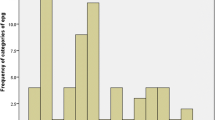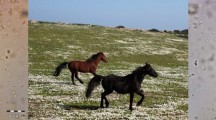Abstract
As many ewes and lambs watered at concrete ponds in well-drained sites acquired fluke infection as those watered at natural ponds in areas suitable for the snail intermediate hosts of Fasciola hepatica. Fasciola transmission, as evidenced by the increasing number of seropositive hosts in an enzyme-linked immunosorbent assay (ELISA), occurred during the heavy rainy period of July–September and declined with the onset of the dry season, being succeeded by the emergence of faecal positive hosts. This indicates the superiority of ELISA over coprological techniques in the early diagnosis and seroepidemiology of this parasitic infection. Host productivity, as reflected in weight gains and haematological parameters, was not significantly affected by the fluke infections.
Similar content being viewed by others
References
Doney, J.M., Peart, J.N. and Smith, W.F. 1981. The effect of interaction of ewe and lamb genotype on milk production of ewes and growth of lambs to weaning. Animal Production, 33, 137–142
Dorsman, W. 1956. A new technique for counting eggs of Fasciola in cattle faeces. Journal of Helminthology, 30, 165–172
Erich, J. 1983. Investigation of fascioliasis in the Ethiopian highlands around Debre Berhan, (MSc thesis, University of Leiden, The Netherlands), 1–29
Gemetchu, B. and Mamo, E. 1979. A preliminary survey of bovine fascioliasis in Ethiopia. Ethiopian Journal of Agriculture Science, 1, 5–12
Goll,P.H. and Scott, J.M. 1978. The inter-relationship of Lymnaea truncatula and ovine fascioliasis in the Ethiopian Central Highlands. British Veterinary Journal, 134, 551–555
Graber, M. 1978. Helminths and helminthiasis of domestic and wild animals of Ethiopia. Institut d'Elevage et de Medecine Veterinaire des pays Tropicaux, 1, 13–195
Gryseels, G. and Anderson, F.M. 1983. Studies on the traditional agricultural system. ILCA Research Report No. 4, (ILCA, Addis Ababa, Ethiopia), 7–22
Lemma, B., Fisseha, G-ab. and Shibru, T. 1985. Studies on fascioliasis in four selected sites in Ethiopia. Veterinary Parasitology, 18, 29–37
Lowry, O.H., Rosenbrough, N.J., Farr, A.L. and Randell, R.J. 1951. Protein measurement with the folin reagent. Journal of Biological Chemistry, 193, 265–275
Njau, B.C., Kasali, O.B. and Scholtens, R.G. 1989. Serodiagnosis of Fasciola hepatica infestations in sheep: survival of the fluke metacercaria in hay. Veterinary Parasitology, (in press)
Njau, B.C., Nyindo, M. and Mutani, A. 1986. Immunological responses and the role of the paralysing toxin in rabbits infested with Rhipicephalus evertsi evertsi. American Journal of Tropical Medicine and Hygiene, 35, 1248–1255
Peart, J.N. 1968. Lactation studies with black face ewes and their lambs. Journal of Agriculture Science (Cambridge), 70, 87–94
Sandeman, R.M. and Howell, M.J. 1980. In vitro studies of the response of sheep to infection with Fasciola hepatica. Veterinary Parasitology, 6, 347–357
SAS 1985. SAS User's Guide: Statistics, 5th edn., (SAS Institute Inc., Cary, NC, USA)
Scott, J.M. and Goll, P.H. 1977. The epidemiology and antihelminthic control of ovine fascioliasis in the Ethiopian Central Highlands. British Veterinary Journal, 133, 273–280
Tembely, S., Galvin, T.J., Craig, T.M. and TraoreS. 1988. Liver fluke infections of cattle in Mali. An abattoir survey on prevalence and geographic distribution. Tropical Animal Health and Production, 20, 117–121
Treacher, T.T. 1973. Artificial rearing of lambs a review. Veterinary Record, 92, 311–315
Voller, A., BidwellD.E. and BartlettA. 1979. The enzyme-linked immunosorbent assay (ELISA). A guide with abstracts of microplate applications, (Dynatech Europe, Guernsey, Channel Islands), 5–8
Author information
Authors and Affiliations
Rights and permissions
About this article
Cite this article
Njau, B.C., Kasali, O.B., Scholtens, R.G. et al. The influence of watering practices on the transmission of Fasciola among sheep in the Ethiopian highlands. Veterinary Research Communications 13, 67–74 (1989). https://doi.org/10.1007/BF00366854
Accepted:
Issue Date:
DOI: https://doi.org/10.1007/BF00366854




